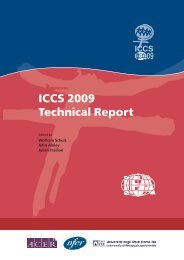Teacher Education and Development Study in Mathematics - IEA
Teacher Education and Development Study in Mathematics - IEA
Teacher Education and Development Study in Mathematics - IEA
Create successful ePaper yourself
Turn your PDF publications into a flip-book with our unique Google optimized e-Paper software.
44<br />
TEACHER PAY AND STUDENT MATHEMATICS ACHIEVEMENT<br />
mathematics skills <strong>in</strong>to the profession. But aga<strong>in</strong>, without a historical events analysis, it<br />
is difficult to determ<strong>in</strong>e if the high mathematics skills were there before union impact<br />
or if the high mathematics skills were the result of unions rais<strong>in</strong>g salaries <strong>and</strong> attract<strong>in</strong>g<br />
highly skilled <strong>in</strong>dividuals <strong>in</strong>to teach<strong>in</strong>g.<br />
Keep<strong>in</strong>g these complexities <strong>in</strong> m<strong>in</strong>d, we estimated the relationship between the teacher/<br />
scientist salary ratio <strong>and</strong> student performance on the mathematics portion of the TIMSS<br />
<strong>and</strong> PISA tests. All of the countries for which we estimated relative teacher salaries had<br />
participated <strong>in</strong> TIMSS 2003 or PISA 2003. We first needed to estimate a TIMSS score<br />
<strong>and</strong> a PISA score for each of the 20 countries <strong>in</strong> our sample that participated <strong>in</strong> one or<br />
other of the tests. Fourteen of the 20 countries participated <strong>in</strong> TIMSS <strong>and</strong> 11 <strong>in</strong> PISA. In<br />
total, 17 countries <strong>in</strong> the world (<strong>in</strong>clud<strong>in</strong>g many not <strong>in</strong> our sample) participated <strong>in</strong> both<br />
tests that year. From those 17 scores, we estimated a relationship between the scores <strong>and</strong><br />
used that relationship to estimate TIMSS scores for those countries <strong>in</strong> our sample where<br />
students sat the PISA but not the TIMSS test. We also used the relationship to estimate<br />
PISA scores for those countries <strong>in</strong> which the students sat the TIMSS test but not the<br />
PISA. 6 Table 10 shows the average scores of students <strong>in</strong> each country <strong>in</strong> our sample. The<br />
imputed TIMSS <strong>and</strong> PISA scores for 2003 are <strong>in</strong>dicated <strong>in</strong> bold font.<br />
Table 10: TIMSS <strong>and</strong> PISA <strong>Mathematics</strong> Scores, by Country, 2003<br />
Country TIMSS <strong>Mathematics</strong> Scores PISA <strong>Mathematics</strong> Scores<br />
Australia 505 524<br />
Botswana 366 358<br />
Bulgaria 476 460<br />
Chile 387 377<br />
Ch<strong>in</strong>ese Taipei 585 562<br />
F<strong>in</strong>l<strong>and</strong> 551 544<br />
France 525 511<br />
Germany 518 503<br />
Hong Kong SAR 586 550<br />
Italy 484 466<br />
Korea 589 542<br />
Mexico 424 385<br />
Philipp<strong>in</strong>es 378 369<br />
S<strong>in</strong>gapore 605 581<br />
Spa<strong>in</strong> 504 485<br />
Switzerl<strong>and</strong> 537 527<br />
Thail<strong>and</strong> 450 417<br />
United K<strong>in</strong>gdom 498 481<br />
United States 504 483<br />
Source: TIMSS—Mullis, Mart<strong>in</strong>, Gonzalez, <strong>and</strong> Chrostowski (2004).<br />
6 The estimated relationships were as follows:<br />
R 2 = 0.73);<br />
R 2 = 0.73).<br />
When we developed estimates for the 1999 TIMSS score compared to the 2000 PISA score, based on the 22<br />
countries that took both tests <strong>in</strong> those years, we found very similar results, although R 2 (0.70) was slightly lower.

















